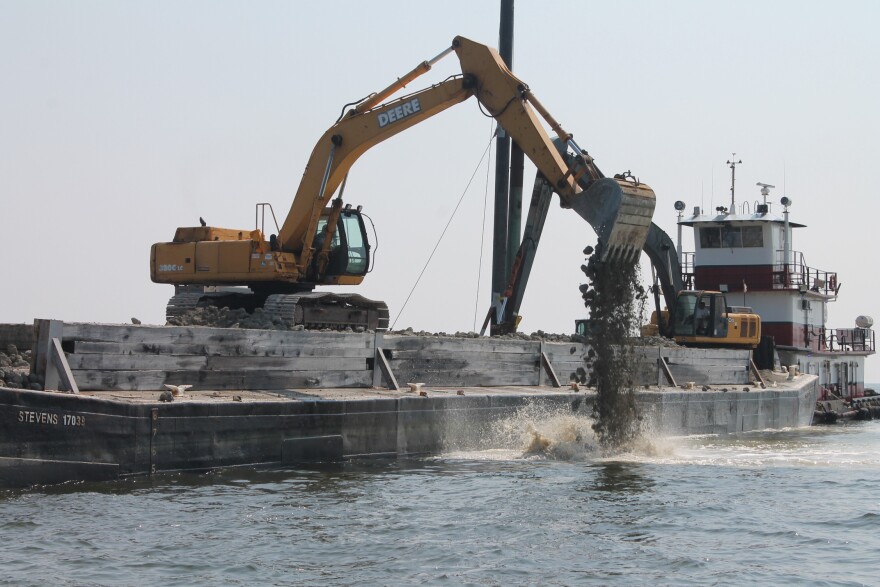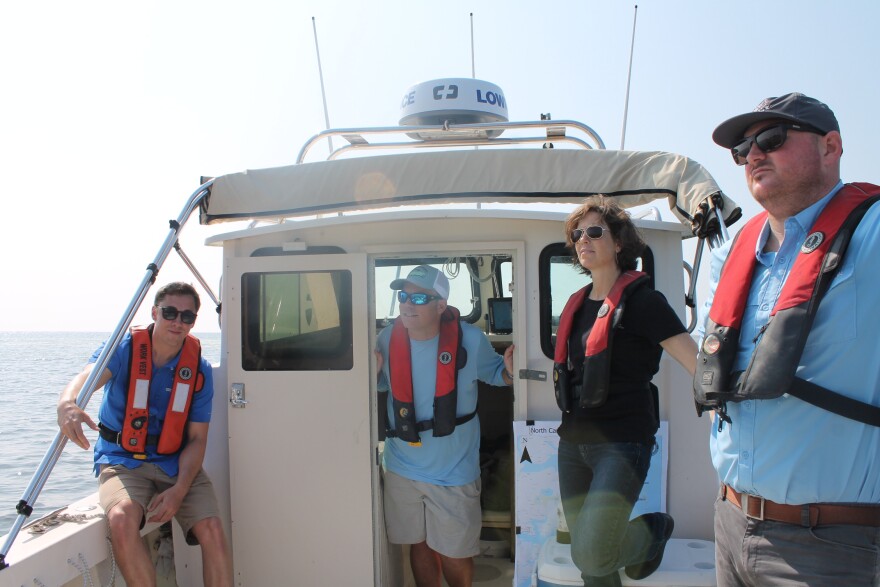Oysters — you either love 'em or hate 'em. Regardless of whether you like them raw, fried or not at all, they're big industry in North Carolina — nearly $30 million dollars annually. To support that industry and protect oysters from overharvesting are oyster sanctuaries— dedicated areas in the Pamlico Sound where oysters can grow freely, no harvesting allowed. PRE’s Ryan Shaffer visited one oyster sanctuary just as its construction was wrapping up.
I took a boat about 5 miles off the coast of Cedar Island. There the North Carolina Coastal Federal is finishing up its 75-acre oyster sanctuary. It’s one of many that dot the Pamlico Sound. Bennett Paradis is an oyster sanctuary biologist with the North Carolina Division of Marine Fisheries.
“We’ve got 15 sites that are currently protected and they more or less act as a brood stock – they act as a safety net for larval protection.”
This is all part of a decades-long goal of building 500 acres of oyster sanctuaries off North Carolina’s coast by 2025. The site at Cedar Island was completed last week and brings the total to 450 acres.
Oyster restoration efforts began in the early 1900s after decades of overharvesting. The push for protected areas where harvesting is not allowed began in the 1990s. Erin Fleckenstein is the Oyster Program Director for the Coastal Federation.
“Oysters are a really important species in our sounds. They’re what we call a keystone species.”
Oysters help to filter water and provide habitat for southern flounder, blue crabs and other marine animals. Fleckenstein says oyster reefs serve a similar function for the Sound as coral reefs do for the Gulf.
“When you think of, you know, like a coral reef, they are essentially the reef structure of our sounds here in North Carolina creating those same benefits of the habitat refuge for small and. Animals feeding grounds for larger animals, and they're just a really integral part of our sound. Sometimes we also call them the Canary of the estuary in that we can tell how healthy the ecosystem is by whether or not the oysters are thriving.”

Creating these artificial reefs is no small feat. The Cedar Island site has taken 3 years to complete. It took several trips, loading thousands of pounds of rock onto a barge and tossing it into the Sound. Will Hollowell is with Steven’s Towing, the contractor carrying out the work.
“We have a 170-foot barge, and it carries about 750 tons of cargo,” Hollowell said.
The rocks used are limestone marl, quarried from a site in New Bern. They’re placed in long rows, or ridges. Hollowell said with each trip, they can build about two ridges. One hundred ten ridges were built for the whole sanctuary.
Once the rocks are in the water, all that’s left is for the oysters to locate there. But how the stationary mollusks find their new home is a product of their unique breeding habits.
“Oysters are only mobile for about two weeks when they're baby larvae,” Fleckenstein said. “Adults release the eggs and sperm into the water –that's called broadcast spawning. They find each other, fertilize the eggs, and then you have a free swimming oyster larvae for about two weeks. And then . . . they actually create an eye and a foot, and the eye helps them sort of detect gravity and light. And the foot helps them cement themselves onto a hard substrate. So, what we're doing is providing them with that hard substrate to land on so that they can grow up and mature.”
The benchmark for a successful sanctuary is 50 oysters per square meter, but Paradis says the sanctuaries they’ve built outperform that goal.
“We've got three reefs that are more than 25 years old now, and they're still supporting oysters above 50 oysters per square meter,” Paradis said. “We often see sanctuary sites support more than 1,000 oysters per square meter."
The Coastal Federation still has work to do on the state’s 500-acre goal. In May, it received $15 million dollars from a federal NOAA grant for a project that will push it past the finish line. Jordan Byrum handles the logistics for the Federation’s oyster projects.
“We’re on the cusp of a big multi-year project,” Byrum said, adding it will likely begin next year. “Right now, we’re laying the groundwork.”
Oyster sanctuaries are just one strategy to promote the state’s oyster industry, which is expected to reach $100 million annually by the end of the decade. The Coastal Federation also recycles oyster shells that will go toward helping restore oyster reefs and has an oyster harvesting demonstration site near Wanchese.




